
Bucaramanga, the outdoor and adventure capital of Colombia, is calling! This vibrant, green “City of Parks” is your gateway to the fascinating Santander region, full of hidden gems, historic towns and breathtaking landscapes – perfect for history and nature lovers, outdoor enthusiasts and thrill-seekers.
Here are 18 cool things to do in Bucaramanga and the rest of Santander.
Close to the beautiful central square Parque García Rovira, you can discover several impressive historic sites, including the Palacio de la Justicia, the Sagrada Familia cathedral, the Casa de Bolívar (where Simón Bolívar stayed during his travels), the Parroquia de San Laureano, as well as the Nuestra Señora de los Dolores chapel. The colonial Casa Luis Perú de Lacroix is a great place to learn about the history of Bucaramanga.
Walking uphill in (north-)eastern direction, you will find beautiful parks, as well as nice restaurants, cafés and bars.
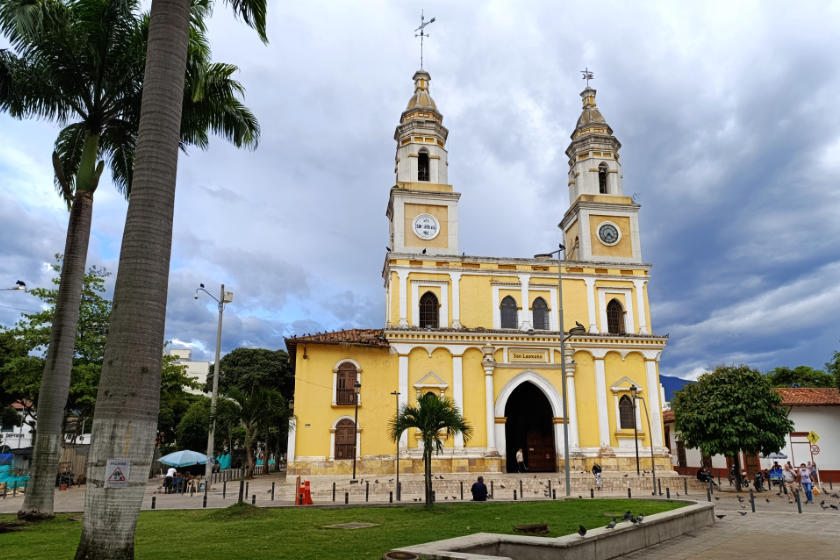
Photo by Nicole (Travelhapp), Parque García Rovira, Bucaramanga
Bucaramanga and the department of Santander as a whole are featuring a growing craft beer scene. Independent local breweries are often characterized by their small-scale production, focus on unique and creative flavors, and commitment to the craft beer community. You can try local craft beer, for example, in Sanders Cervecería Artesanal (Google Maps) and Chicamocha Pub (Google Maps) in Bucaramanga, and in Medieval Cervecería Artesanal (Google Maps) in Floridablanca.
You can reach residential Floridablanca with its relaxed atmosphere in a 15 minutes drive from the center of Bucaramanga.
Catch a cable car up to Cerro del Santísimo and take the elevator to the panoramic platform on top of the giant Jesus statue to enjoy 360° views of the surroundings. (Make sure to check current opening hours beforehand on Google Maps.)
Afterwards, take a relaxed stroll in the Eloy Valenzuela Botanical Garden which features over 3,500 plant species including orchids and heliconias.
In a stunning setting just outside of Floridablanca you will find Ecoposada Montefiore (Google Maps), an eco-friendly lodge and natural reserve focused on sustainable tourism.
Girón is a colonial town of great historical and cultural significance just a 15 minutes drive away from Bucaramanga. Walk along the cobblestone streets, relax in the main square admiring the beautiful colonial architecture, visit a museum and enjoy the local cuisine in a traditional restaurant. View our TikTok video for more impressions of Girón.

Photo by Nicole (Travelhapp), Girón, Santander
You can find many art galleries in the barrios San Francisco and neighbouring San Alonso, as well as in Cabecera del Llano and bohemian Provenza. San Francisco is also home to important cultural centers, like Casa de la Cultura and Centro Cultural del Oriente.
The Museo de Arte Moderno (MAMB) is located in the historical center of Bucaramanga and totally worth visiting. With its diverse collection, rotating exhibitions and beautiful sculpture garden, MAMB provides a platform to engage with both Colombian and international modern art.
Mercado Campesino is a traditional farmers’ market in the Provenza neighborhood of Bucaramanga. It’s a fantastic place to try local street food and enjoy the visual and olfactory beauty of fresh vegetables and fruit. Another food market worth visiting is the Mercado Central at Plaza Central in the center of Bucaramanga.
Some say Bucaramanga offers Colombia’s best cuisine. The Santander department and Bucaramanga also feature some of Colombia’s most extravagant food, including hormigas culonas (literary “thick-butt ants”), large, roasted ants. A little less adventurous but also very typical is Cabrito (or Cabro), roasted or fried goat meat, marinated in garlic, cumin, and other spices. Other traditional dishes include mute santandereano (a delicious soup), tamales santandereanos, carne oreada, pepitoria (intestines), chorizo del Valle de San José (sausage), and arepas santandereanas. Must-try desserts are Obleas de Floridablanca (oblates prepared with arequipa and other ingredients) and bocadillo Veleño (based on the Guayaba fruit).
Some great restaurants serving typical food are Mercagán Parrilla at Parque San Pio (Google Maps), La Puerta del Sol (Google Maps), and Hernando Parrilla (Google Maps). If you want to have lunch with a scenic view, you can find several restaurants with outside terraces in the Eco Park Palonegro (Google Maps) outside of Girón. It’s better to go during the week, since it’s difficult to get a good table with a view during weekends and holidays.

Photo by jkraft5, Hormigas Culonas (mod.)
If you have the time, attend a performance at Casa del Libro Total or Teatro Coliseo Peralta to immerse yourself in the local culture scene. Casa del Libro Total is a cultural center in downtown Bucaramanga, housed within a restored colonial building. It offers a diverse range of events including musical performances, poetry recitals, literature readings, and art exhibitions.
The neoclassical Teatro Coliseo Peralta is one of Colombia’s oldest theaters and hosts a wide array of cultural performances ranging from theater and concerts to ballet and films.
University town Bucaramanga has a vibrant nightlife and the Zona Rosa is among the best places to go out at night. Situated along Calle 31 between Carrera 33 and 34, the Zona Rosa is lively throughout the day and features various types of clubs with different musical styles, as well as a great choice of restaurants and bars.
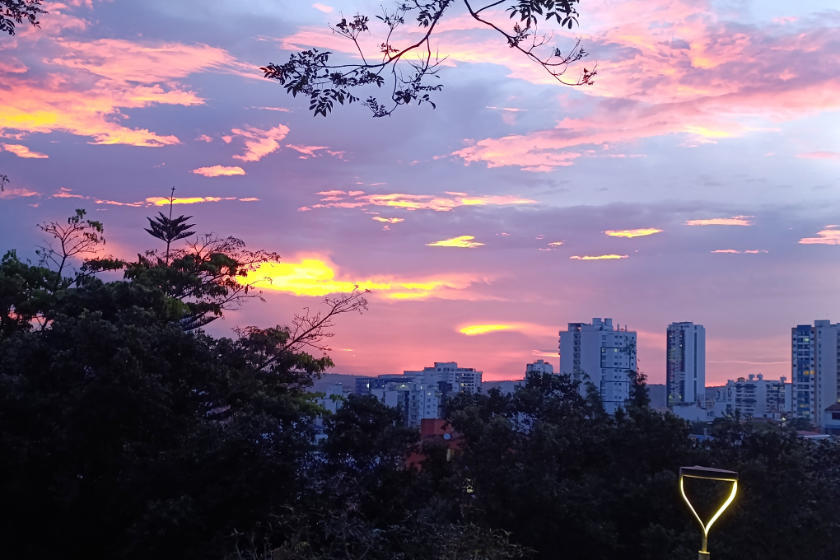
Photo by Nicole (Travelhapp), View of Bucaramanga at sunset from Bosque Encantado
Bucaramanga is called “City of Parks” for good reason: it boasts a multitude of green parks and recreational nature oasis within the city.
Parque del Agua enchants with its beautiful wooden paths, refreshing waterfalls, pools, and tropical plants. Parque Ecológico La Flora was once a neglected ravine, and has been transformed into an expansive green haven through community efforts. Now the park offers a unique opportunity to connect with nature and engage in recreational activities.
San Pío Park features the famous Botero statue “Mujer de Pie desnuda” (woman with naked foot). Just a few steps away is the beautiful small Parque Las Palmas.
The newly opened Parque Bosque de Lagos de Cacique offers beautiful city views at sunset. A little closer to the central districts of El Prado and Cabecera lies Bosque Encantado which also offers amazing sunset views. And these are just a few of Bucaramanga’s parks…
There are also numerous ecological hiking trails around Bucaramanga and Floridablanca. Have a look at Vanguardia’s article (in Spanish, with pictures) to get a first idea. For hikes in the hills around the city it’s generally better to go in a group and during the weekend, when there are more people around.
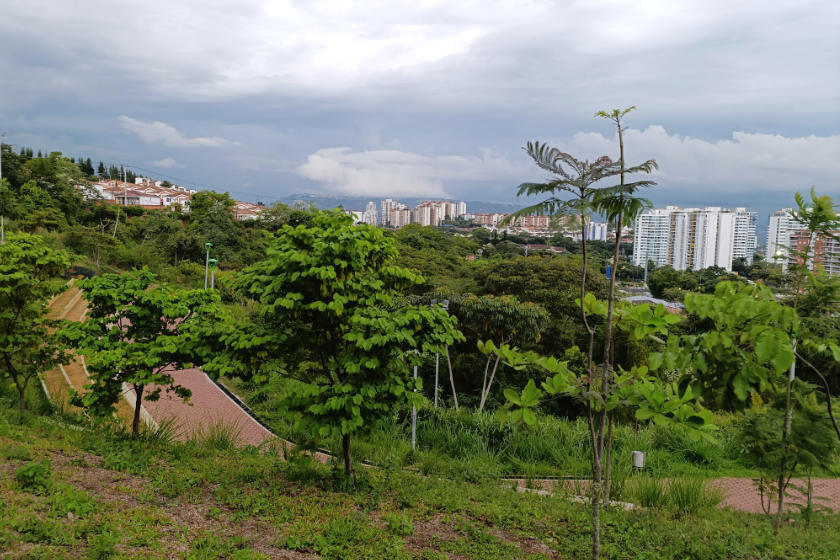
Photo by Nicole (Travelhapp), View of Bucaramanga from Cacique Park
While Bucaramanga city is a great place to pass some time with its many parks and fine cuisine, the area’s main attractions are located outside of the city. The Santander department is truly enchanting!
There’s a unique, peaceful atmosphere in the countryside, with its charming little towns, beautiful mountains, and hills. As a passionate walker, I find Santander perfect for a slow and relaxed exploration by foot.
This incredibly diverse region is brimming with secret treasures – from the hidden Gachas de Guadalupe to the quaint town of Guane and the fascinating village of San Vicente de Chucuri with its cacao farms and stunning landscapes. And, of course, there are endless opportunities for the things the region is most known for: extreme sports and adventure activities.
Here are some recommended day trips from Bucaramanga, or – even better – stopovers on your way to another destination.
The Chicamocha Canyon is dubbed the “Grand Canyon of Colombia”, and is one of the largest canyons in the world. It’s a dream destination for outdoor and adventure enthusiasts, featuring activities such as hiking, paragliding (Viator.com*), bungee jumping, zip-lining, rock climbing, extreme swing, rafting, and more.
Even if you are not into extreme sports the Chicamocha Canyon is a top place to visit in Colombia. The peace on top of the mountain feels transcendental and the views are indescribable. While there are restaurants on Mesa de los Santos, the culinary offer inside the Chicamocha park is bigger and the setting of the restaurants and cafés is more spectacular.
You can access the canyon either via the main park entrance (ca. 1,5 hours from Bucaramanga) or via cable car from Mesa de los Santos, a unique flat-topped mountain (ca. 45 minutes from Bucaramanga). Check out the operating hours of the cable car (Teleférico Panachi) on Google Maps before going.
Get more impressions of the Chicamocha Canyon in our TikTok video.

Photo by Nicole (Travelhapp), Panachi cable car across Chicamocha Canyon

Photo by Nicole (Travelhapp), El Gallineral Natural Park, San Gil
A bus from Bucaramanga will take you down south to San Gil in 2-3 hours. There is also a direct bus connection from Chicamocha to San Gil.
Beautifully set, San Gil is dubbed the “Rafting Capital of Colombia”, or even the “Outdoor and Adventure Capital”. Apart from white water rafting, there’s a range of other adventure activities you can engage in, like bungee jumping, mountain biking, caving and paragliding, to name just a few. Another 30 minutes South of San Gil, you can visit the impressive waterfalls Cascadas de Juan Curi (Google Maps).
Below I’ve selected some fun adventure activities available for online booking via my affiliate partner GetYourGuide*.
A little off the beaten track you can find charming Mogotes which is reachable in just 30 minutes from San Gil. This secret ecotourism destination is home to waterfalls, natural pools, interesting rock formations and more. Curiti is another hidden gem with a colonial center and beautiful natural surroundings which are great for outdoor activities.
In a 30 minutes bus drive from San Gil you reach one of Colombia’s most beautiful colonial towns: Barichara. Barichara has been declared a national monument of Colombia due to its historic and cultural significance. As if this was not enough, Barichara is also set in stunning natural surroundings and offers world class gastronomy.
One of my favorite things to do in Barichara was hiking along the Camino Real to nearby hidden gem Guane. This “royal path”, declared a national monument in 1977, was originally laid out by the indigenous Guane people of the region and was used in colonial times for commercial trade. It leads you through a strikingly beautiful landscape and enchants with incredible views. About halfway there is a nice, simple café with great iced coffee! Small and picturesque Guane features a well-preserved colonial architecture, cobblestone streets, and laid-back atmosphere.
The hike from Barichara to Guane took me about 2 hours of relaxed walking with breaks.I hiked alone but wouldn’t have minded some company, as there weren’t many people on the trail despite it being Sunday. Maybe you’ll find someone in your hotel/hostel to join you! On GetYourGuide, you can also book an organized hiking tour from Barichara to Guane*, as well as other exciting tours like the Barichara-Cabrera hike* through the Rio Suarez Canyon and the extreme trek from Barichara to the Chicamocha Canyon*.
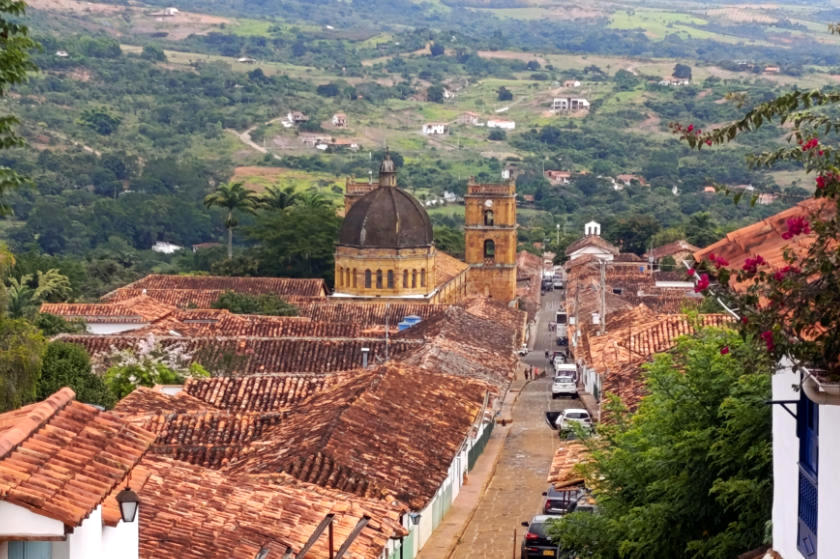
Photo by Nicole (Travelhapp), Barichara
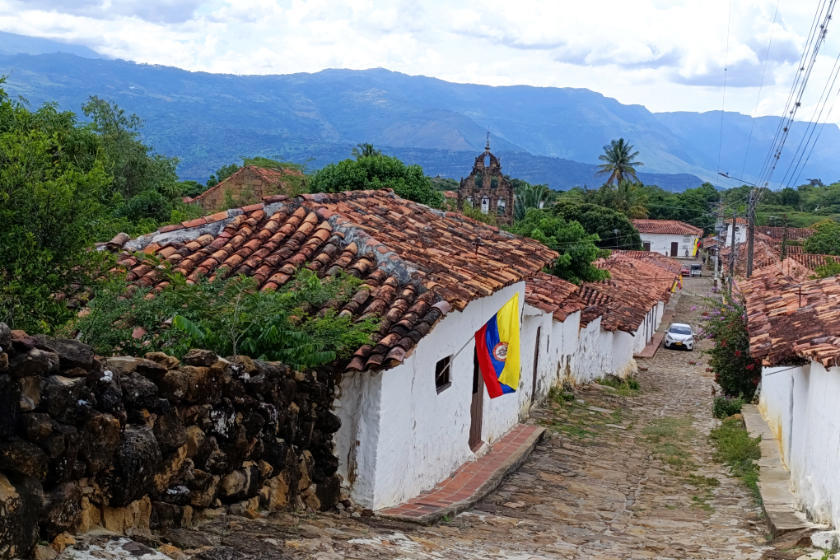
Photo by Nicole (Travelhapp), Guane, Santander
A historically important destination in Santander is Socorro. Socorro is part of Colombia’s Heritage Towns Network since several significant events leading to Colombia’s independence took place there, from Manuela Beltrán’s initiation of the Comunero Revolt to the signing of the country’s first Act of Independence.
Visit the old town between Parque Principal del Socorro and Parque de La Chiquinquirá, and don’t miss the beautiful Convent of the Capuchin Monks east of the center. Don Mario serves excellent coffee from local farms in Carrera 14 (view on Google Maps).
The surroundings of Socorro provide opportunities for ecological, adventure and outdoor activities.

Photo by Nicole (Travelhapp), Manuela Beltrán statue, Convent of the Capuchin Monks
Charming hidden gem Guadalupe does not only feature a picturesque center with a beautiful church and main square, it’s also a great outdoor travel destination offering activities like hiking and body rafting. The most iconic sight in Guadalupe is its multi-colored river with its “natural jacuzzis”, known as the Gachas de Guadalupe. A beautiful hiking trail leads from the edge of the village to this natural wonder.
Make sure to stop in Guadalupe if you are traveling between Villa de Leyva and Bucaramanga or San Gil!

Photo by Nicole (Travelhapp), Gachas de Guadalupe
The department of Santander is a great travel destination for lovers of caves and caving. You usually need to go with a local guide to visit the caves.
About 2 hours from Bucaramanga, in Zapatoca, you will find Cueva del Nitro (Google Maps), a cave system known for its unique formations. Around 30 minutes South of San Gil you can visit the Cueva del Indio (Google Maps), while 20 minutes North-East of San Gil, near Curití, you’ll encounter Cueva de la Vaca.
Near San Vicente de Chucuri, magical Cueva de los Aviones (Google Maps) is known for its Swift birds and waterfalls. Some local tour operators offer private tours to Cueva de los Aviones (Viator.com*) from Bucaramanga, however, prices vary depending on the group size and are a bit high for solo travelers.
The mountain village San Vicente de Chucuri, located about 3 hours by bus from Bucaramanga (see Rome2Rio), is one of Santander’s best kept secrets. The region of San Vicente de Chucuri produces a large part of Colombia’s Cacao and we highly recommend to visit a local Cocoa farm to learn about the process and do tastings. Make sure to also try one of the delicious end products, Chocolate de Santander.
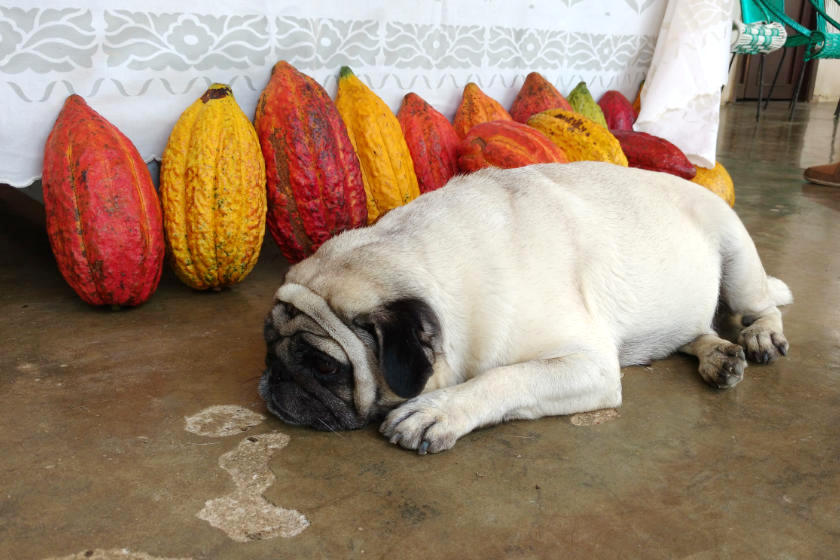
Photo by Nicole (Travelhapp), Cocoa farm in San Vicente de Chucuri
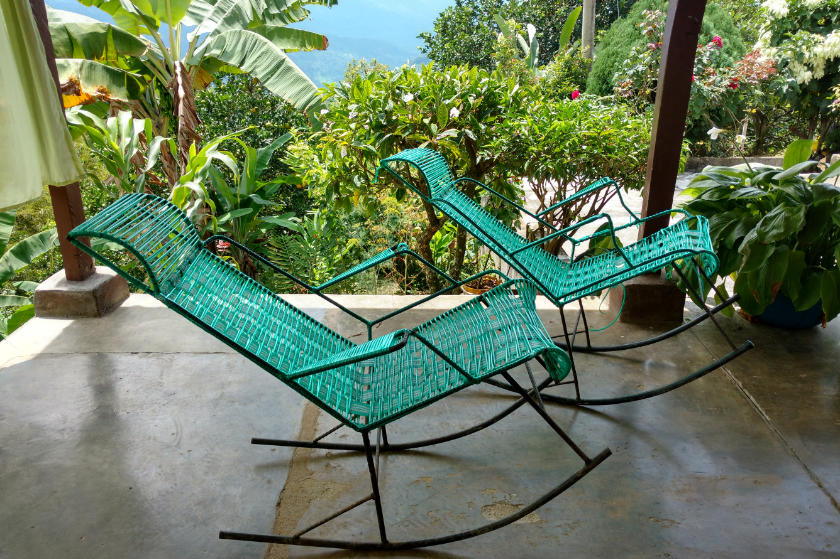
Photo by Nicole (Travelhapp), Cocoa farm in San Vicente de Chucuri
Nice areas to stay in Bucaramanga include Cabecera del llano and El Prado. If you prefer a more colonial setting you may also opt for nearby Girón. In Bucaramanga, Girón and Floridablanca you can get an excellent price-quality ratio in all categories of hotels and hostels. Here are my picks.
Bucaramanga is a great travel destination for solo travelers. There are a lot of things to do and see in Bucaramanga and Santander and public transport connections are good and cheap.
Bucaramanga is usually listed among the safest big cities in Colombia. As always when traveling you should apply some precautions. Please have a look at my Safety Tips for Solo Travelers in Colombia and Solo Travel Guide. When it comes to hiking, trekking and other nature and outdoor activities, in Colombia it’s better to go in a group.
Bucaramanga is situated at an altitude of approximately 960 meters (3,146 feet) and features a mild and pleasant weather and climate throughout the year. Daytime temperatures usually range from around 24°C to 28°C (75°F to 82°F), nighttime temperatures oscillate around 19°C/20°C (66°F/68°F). Bucaramanga’s dry season is typically from December to February; May and October are among the wettest months .
Two great festivals in Bucaramanga are SANFICI, an international festival of independent film, and Abrapalabra, which used to bring together storytellers, musicians, poets, comedians, and dancers from around the world. While SANFICI has already taken up activities again after the Pandemic, Abrapalabra has unfortunately not announced any new dates yet. Follow them on Instagram (@sanficifestival and @festivalabrapalabra) to learn about the latest announcements.
If you like traveling overland, here are some interesting destinations to reach by bus in less than 12 hours.
Heading South from Bucaramanga you get to some of Colombia’s top travel destinations.
Villa de Leyva (7h): Villa de Leyva is an extremely beautiful colonial town in the Andes. You can catch a bus from Bucaramanga to Tunja (6 hours), and then another bus from Tunja to Villa de Leyva (40 minutes). On the way from Bucaramanga to Tunja, there are several other interesting travel destinations close by, including San Gil, Barichara, Guadalupe, Socorro (see above), and Suaita. Read more about Villa de Leyva.
Bogotá (10h): Bucaramanga and Bogotá are well connected by bus and the journey takes about 10 hours (see Rome2Rio for details). You may consider stopping over in Villa de Leyva, or one of the smaller but equally charming colonial towns Socorro and Charalá. In Charalá Simón Bolívar signed the Act of Independence of Colombia in 1813. View Insider Tips on Activities in Bogotá.
Medellín (10h): The bus ride from Bucaramanga to Medellin takes about 8-11 hours depending on the route and bus company (see Rome2Rio for details). Get inspirations what to do in Medellin.
From Bucaramanga you can go straight to one of Colombia’s most popular and fascinating travel destinations in the North, Santa Marta.
If you are up for exploring untapped territories, you may consider visiting Valledupar or the department of Norte de Santander with its main cities Cúcuta and Pamplona. (Please check current travel advice for Norte de Santander before going; there may be travel warnings for parts of the department due to the presence of guerilla groups.)
Here’s a little more information on the cities up North:
Santa Marta (10h): Santa Marta is set between the Caribbean sea and the lush green Sierra Nevada de Santa Marta mountains, offering a plethora of interesting outdoor activities. See our recommendations on things to do in Santa Marta. You can get from Bucaramanga to Santa Marta in around 10 hours by bus (see details on Rome2Rio).
Valledupar (8h): The bus from Bucaramanga to the hidden gem Valledupar takes about 8 hours (see Rome2Rio). Here are some Inspirations on Things to do in Valledupar.
Pamplona (3h): The historical city of Pamplona with its beautiful colonial buildings and colorful streets is a fantastic off the beaten track destination in Colombia’s north. The city has a vibrant culture scene and offers interesting outdoor activities nearby, such as hiking, horseback riding, and birdwatching. The bus ride from Bucaramanga takes about 3 hours (see Rome2Rio). You could visit Pamplona even in a day trip from Bucaramanga, if you get up early.
Cúcuta (5h): From Pamplona you reach fascinating Cúcuta at the border to Venezuela in 2 hours (see Pamplona-Cúcuta bus connection on Rome2Rio). This historical city offers a vibrant local culture which blends colombian and venezuelan influences. It’s also an interesting ecotourism destination since it offers beautiful nature spots in and outside of the city. Get more information on Things to do in Cúcuta and Pamplona.
Share your thoughts!
Questions or comments? I’d love to hear them! Reach out on Instagram, Facebook or TikTok.
Share this post:
Last Update: August 18, 2025
Image Credit: Title image on top by Ricardo Gomez Angel, Chicamocha Canyon, Bucaramanga (mod.)
Affiliate links (*): Some links on this page are affiliate links. By booking through these links, you can support my work on Travelhapp – at no extra charge to you. I only recommend products and services I trust and believe will provide value to you.
© 2025 Travelhapp.com
To provide the best experiences, we use technologies like cookies to store and/or access device information. Consenting to these technologies will allow us to process data such as browsing behavior or unique IDs on this site. Not consenting or withdrawing consent, may adversely affect certain features and functions. View our Privacy & Cookie Policy